Details
Joan Miró (1893-1983)
Painting
signé et daté 'Miró 3.31' (au centre); signé et daté 'Joan Miró. 3-31' (au revers)
huile et collage sur métal
18.1 x 20 cm.
Exécuté en mars 1931
signed and dated 'Miró 3.31' (at the centre); signed and dated 'Joan Miró 3-31' (on the reverse)
oil and collage on metal
7 1/8 x 8 in.
Executed in March 1931
Provenance
Georges Hugnet, Paris.
Collection particulière, Paris (acquis auprès de celui-ci avant 1974); vente, Sotheby's, Paris, 8 décembre 2011, lot 24.
Acquis au cours de cette vente par le propriétaire actuel.
Literature
J. Dupin et A. Lelong-Mainaud, Joan Miró Catalogue raisonné. Paintings, 1933-1941, Paris, 2000, vol. II, p. 28, no. 344 (illustré).
Special Notice
Artist's Resale Right ("droit de Suite").
If the Artist's Resale Right Regulations 2006 apply to this lot, the buyer also agrees to pay us an amount equal to the resale royalty provided for in those Regulations, and we undertake to the buyer to pay such amount to the artist's collection agent.
Post Lot Text
« Voici venir les dieux du bois et du fer pour tuer la peinture moderne, la peinture confortable ».
Georges Hugnet
"Here come the gods of wood and iron to kill the modern painting, the comfortable painting"
Georges Hugnet
La subversion ludique des supports traditionnels et l’utilisation de matériaux non artistiques, comme on le voit dans Painting, exécutée en mars 1931, représentent une rébellion contre la prédisposition inhérente à attribuer une valeur aux peintures. À partir du milieu des années 1920, la peinture devient synonyme de mercantilisme et de lâcheté dans les cercles surréalistes ; la réticence à travailler librement avec les matériaux et à prendre des risques en vient à signifier un intérêt superficiel pour le gain monétaire plutôt que le dévouement à la progression de l’avant-garde. En janvier 1931, Miró écrit à son ami espagnol Gasch qu’il est confronté à des « circonstances financières sombres » ; pourtant, dans d’autres lettres de cette époque, l’artiste parle de « battre » ses toiles « à coups de marteau ». Miró est ainsi plus préoccupé par la crise de la peinture que par celle de l’économie (Miró, cité in A. Umland, Joan Miró Painting and Anti-Painting, 1927-1937, New York, 2008 p. 10).
Dans une interview accordée en 1927 au critique d’art Tériade, Miró déclare vouloir « assassiner la peinture ». Cette crise « anti-peinture » se reflète à partir de 1930 dans l’expérimentation de nouvelles techniques et l’utilisation de nouveaux matériaux dans son art. Ainsi, 1931 est l’année des superpositions de matériaux, des collages et des « peintures-objets ». La technique du collage, en particulier, représente une part importante du travail de l’artiste. Miró ne pense pas le collage comme le font les cubistes ; au contraire, comme en témoigne la présente œuvre, il décide de l’appliquer à de nouveaux médias, créant des associations originales, en combinant par exemple l’huile et le collage avec un support métallique. Comme le souligne Margit Rowell, les œuvres de cette période constituent une révolution majeure dans l’œuvre de Miró, et les collages qu’il réalise serviront de source d’inspiration pour les tableaux créés quelques années plus tard, formant l’alphabet d’un langage que l’artiste continuera à utiliser : « Les assemblages que Miró réalise à cette époque sont, par leur économie de moyens et la grande plasticité des matériaux utilisés, de merveilleux pictogrammes poétiques. Autrefois, un détail descriptif avait un rapport avec la réalité ; maintenant, c’est la texture, le rythme des formes, leur dynamisme, l’impression qu’elles laissent dans l’œil et la mémoire du spectateur, qui deviennent la réalité elle-même » (M. Rowell, Joan Miró Peinture = Poésie, Paris, 1976, p. 55).
La présente œuvre est extrêmement rare, car il n’existe qu’une seule autre œuvre peinte sur ce type de métal référencée dans le catalogue raisonné de Miró - toutes deux faisaient partie de la collection de l’artiste surréaliste et ami proche de Miró, Georges Hugnet Ces explorations préfigurent les six peintures à l’huile sur cuivre que Miró exécutera entre 1935 et 1936, parmi lesquelles Homme et femme devant un tas d’excréments, joyau de la Fundació Joan Miró de Barcelone.
The playful subversion of traditional supports and the use of non-artistic materials, as is evident in Painting executed in March 1931, was a rebellion against the inherent predisposition to ascribe value to paintings. From the mid-1920s onwards, painting became synonymous with commercialism and cowardice in Surrealist circles; the reluctance to work freely with materials and take risks came to signify a superficial interest in monetary gain over dedication to the advancement of the avant-garde. Miró wrote to his Spanish friend Gasch in January 1931 of "bleak financial circumstances"; yet, as other letters from the period where the artist spoke of "beating" his canvases "with hammer blows" make clear, Miró was more preoccupied with the crisis in painting than in economics (Miró, quoted in A. Umland, Joan Miró Painting and Anti-Painting, 1927-1937, New York, 2008 p. 10).
In a 1927 interview with the art critic Tériade, Miró declared that he wanted to "assassinate painting". This "anti-painting" crisis was reflected from 1930 onwards in his experimentation with new techniques and materials in his art. As a result, 1931 was the year of superimposed materials, collages and "object-paintings". The collage technique, in particular, represents a significant part of the artist's work. Miró did not think of collage in the Cubist manner; rather, as the present work testifies, he decided to apply it to new media, creating original associations, for example, by combining oil and collage with a metal stand. As Margit Rowell has pointed out, pieces from this period constituted a major revolution in Miró's body of work, and the collages he made at that time would go on to serve as a source of inspiration for the paintings created several years later, forming the alphabet of a prototype language that the artist continued to use from then on: "The assemblages Miró made at the time are, by their economy of means and the great plasticity of the materials used, wonderful poetic pictograms. In the past, a descriptive detail would bear a relationship to reality; now, it is the texture, the rhythm of the forms, their dynamism, and the impression they leave in the eye and the memory of the viewer, that become reality itself" (M. Rowell, Joan Miró Peinture = Poésie, Paris, 1976, p. 55).
The present work is extremely rare, as there is only one other work painted on this type of metal referenced in Miró's catalogue raisonné - both of which were part of the collection of Miró's close friend and surrealist artist, Georges Hugnet These explorations would foreshadow the six oil paintings on copper that Miró would execute between 1935 and 1936, among them Homme et femme devant un tas d’excrément, a jewel in the Fundació Joan Miró in Barcelona.
Details
Joan Miró (1893-1983)
Painting
signé et daté 'Miró 3.31' (au centre); signé et daté 'Joan Miró. 3-31' (au revers)
huile et collage sur métal
18.1 x 20 cm.
Exécuté en mars 1931
signed and dated 'Miró 3.31' (at the centre); signed and dated 'Joan Miró 3-31' (on the reverse)
oil and collage on metal
7 1/8 x 8 in.
Executed in March 1931
Provenance
Georges Hugnet, Paris.
Collection particulière, Paris (acquis auprès de celui-ci avant 1974); vente, Sotheby's, Paris, 8 décembre 2011, lot 24.
Acquis au cours de cette vente par le propriétaire actuel.
Literature
J. Dupin et A. Lelong-Mainaud, Joan Miró Catalogue raisonné. Paintings, 1933-1941, Paris, 2000, vol. II, p. 28, no. 344 (illustré).
Special Notice
Artist's Resale Right ("droit de Suite").
If the Artist's Resale Right Regulations 2006 apply to this lot, the buyer also agrees to pay us an amount equal to the resale royalty provided for in those Regulations, and we undertake to the buyer to pay such amount to the artist's collection agent.
Post Lot Text
« Voici venir les dieux du bois et du fer pour tuer la peinture moderne, la peinture confortable ».
Georges Hugnet
"Here come the gods of wood and iron to kill the modern painting, the comfortable painting"
Georges Hugnet
La subversion ludique des supports traditionnels et l’utilisation de matériaux non artistiques, comme on le voit dans Painting, exécutée en mars 1931, représentent une rébellion contre la prédisposition inhérente à attribuer une valeur aux peintures. À partir du milieu des années 1920, la peinture devient synonyme de mercantilisme et de lâcheté dans les cercles surréalistes ; la réticence à travailler librement avec les matériaux et à prendre des risques en vient à signifier un intérêt superficiel pour le gain monétaire plutôt que le dévouement à la progression de l’avant-garde. En janvier 1931, Miró écrit à son ami espagnol Gasch qu’il est confronté à des « circonstances financières sombres » ; pourtant, dans d’autres lettres de cette époque, l’artiste parle de « battre » ses toiles « à coups de marteau ». Miró est ainsi plus préoccupé par la crise de la peinture que par celle de l’économie (Miró, cité in A. Umland, Joan Miró Painting and Anti-Painting, 1927-1937, New York, 2008 p. 10).
Dans une interview accordée en 1927 au critique d’art Tériade, Miró déclare vouloir « assassiner la peinture ». Cette crise « anti-peinture » se reflète à partir de 1930 dans l’expérimentation de nouvelles techniques et l’utilisation de nouveaux matériaux dans son art. Ainsi, 1931 est l’année des superpositions de matériaux, des collages et des « peintures-objets ». La technique du collage, en particulier, représente une part importante du travail de l’artiste. Miró ne pense pas le collage comme le font les cubistes ; au contraire, comme en témoigne la présente œuvre, il décide de l’appliquer à de nouveaux médias, créant des associations originales, en combinant par exemple l’huile et le collage avec un support métallique. Comme le souligne Margit Rowell, les œuvres de cette période constituent une révolution majeure dans l’œuvre de Miró, et les collages qu’il réalise serviront de source d’inspiration pour les tableaux créés quelques années plus tard, formant l’alphabet d’un langage que l’artiste continuera à utiliser : « Les assemblages que Miró réalise à cette époque sont, par leur économie de moyens et la grande plasticité des matériaux utilisés, de merveilleux pictogrammes poétiques. Autrefois, un détail descriptif avait un rapport avec la réalité ; maintenant, c’est la texture, le rythme des formes, leur dynamisme, l’impression qu’elles laissent dans l’œil et la mémoire du spectateur, qui deviennent la réalité elle-même » (M. Rowell, Joan Miró Peinture = Poésie, Paris, 1976, p. 55).
La présente œuvre est extrêmement rare, car il n’existe qu’une seule autre œuvre peinte sur ce type de métal référencée dans le catalogue raisonné de Miró - toutes deux faisaient partie de la collection de l’artiste surréaliste et ami proche de Miró, Georges Hugnet Ces explorations préfigurent les six peintures à l’huile sur cuivre que Miró exécutera entre 1935 et 1936, parmi lesquelles Homme et femme devant un tas d’excréments, joyau de la Fundació Joan Miró de Barcelone.
The playful subversion of traditional supports and the use of non-artistic materials, as is evident in Painting executed in March 1931, was a rebellion against the inherent predisposition to ascribe value to paintings. From the mid-1920s onwards, painting became synonymous with commercialism and cowardice in Surrealist circles; the reluctance to work freely with materials and take risks came to signify a superficial interest in monetary gain over dedication to the advancement of the avant-garde. Miró wrote to his Spanish friend Gasch in January 1931 of "bleak financial circumstances"; yet, as other letters from the period where the artist spoke of "beating" his canvases "with hammer blows" make clear, Miró was more preoccupied with the crisis in painting than in economics (Miró, quoted in A. Umland, Joan Miró Painting and Anti-Painting, 1927-1937, New York, 2008 p. 10).
In a 1927 interview with the art critic Tériade, Miró declared that he wanted to "assassinate painting". This "anti-painting" crisis was reflected from 1930 onwards in his experimentation with new techniques and materials in his art. As a result, 1931 was the year of superimposed materials, collages and "object-paintings". The collage technique, in particular, represents a significant part of the artist's work. Miró did not think of collage in the Cubist manner; rather, as the present work testifies, he decided to apply it to new media, creating original associations, for example, by combining oil and collage with a metal stand. As Margit Rowell has pointed out, pieces from this period constituted a major revolution in Miró's body of work, and the collages he made at that time would go on to serve as a source of inspiration for the paintings created several years later, forming the alphabet of a prototype language that the artist continued to use from then on: "The assemblages Miró made at the time are, by their economy of means and the great plasticity of the materials used, wonderful poetic pictograms. In the past, a descriptive detail would bear a relationship to reality; now, it is the texture, the rhythm of the forms, their dynamism, and the impression they leave in the eye and the memory of the viewer, that become reality itself" (M. Rowell, Joan Miró Peinture = Poésie, Paris, 1976, p. 55).
The present work is extremely rare, as there is only one other work painted on this type of metal referenced in Miró's catalogue raisonné - both of which were part of the collection of Miró's close friend and surrealist artist, Georges Hugnet These explorations would foreshadow the six oil paintings on copper that Miró would execute between 1935 and 1936, among them Homme et femme devant un tas d’excrément, a jewel in the Fundació Joan Miró in Barcelona.
.jpg)

.jpg)
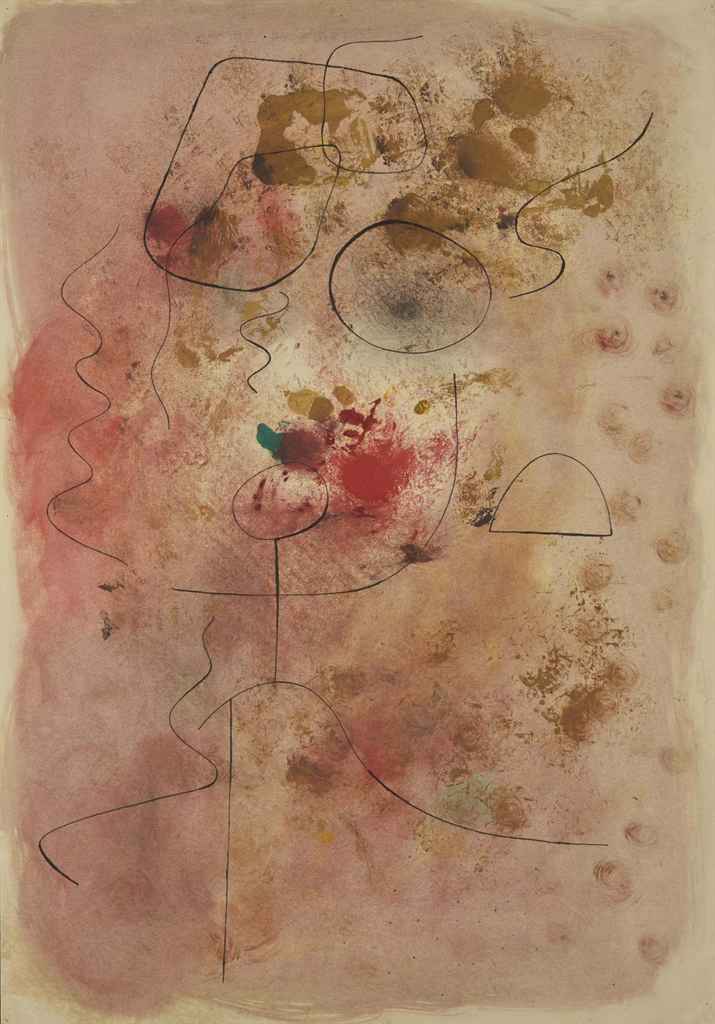
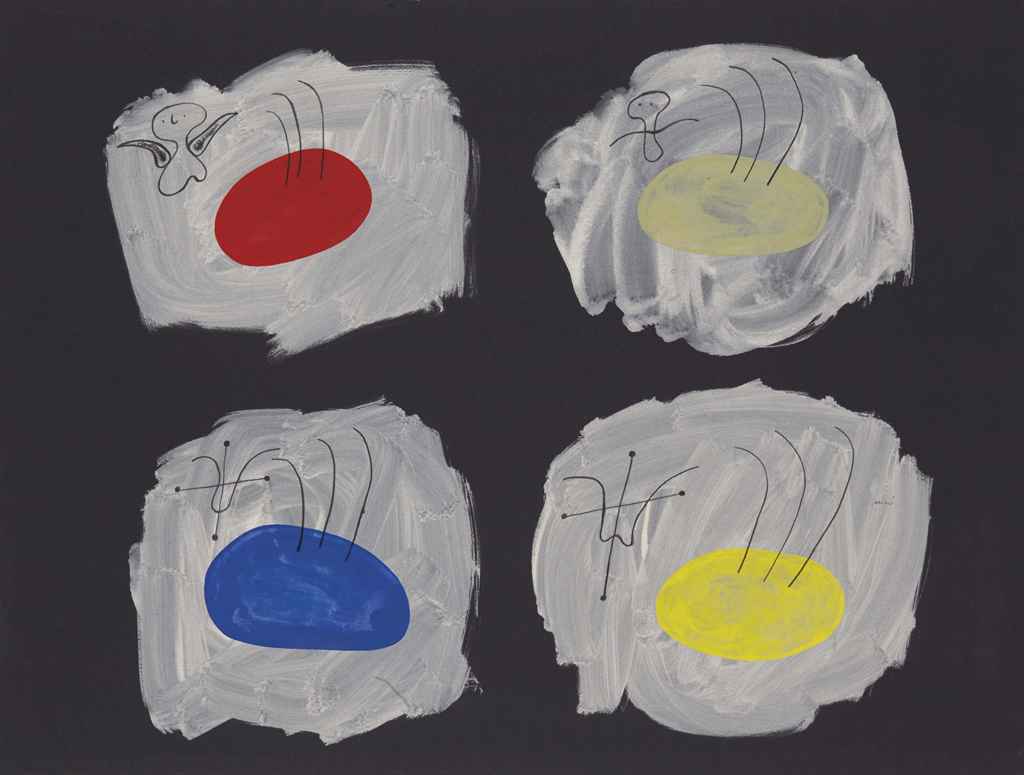
.jpg)
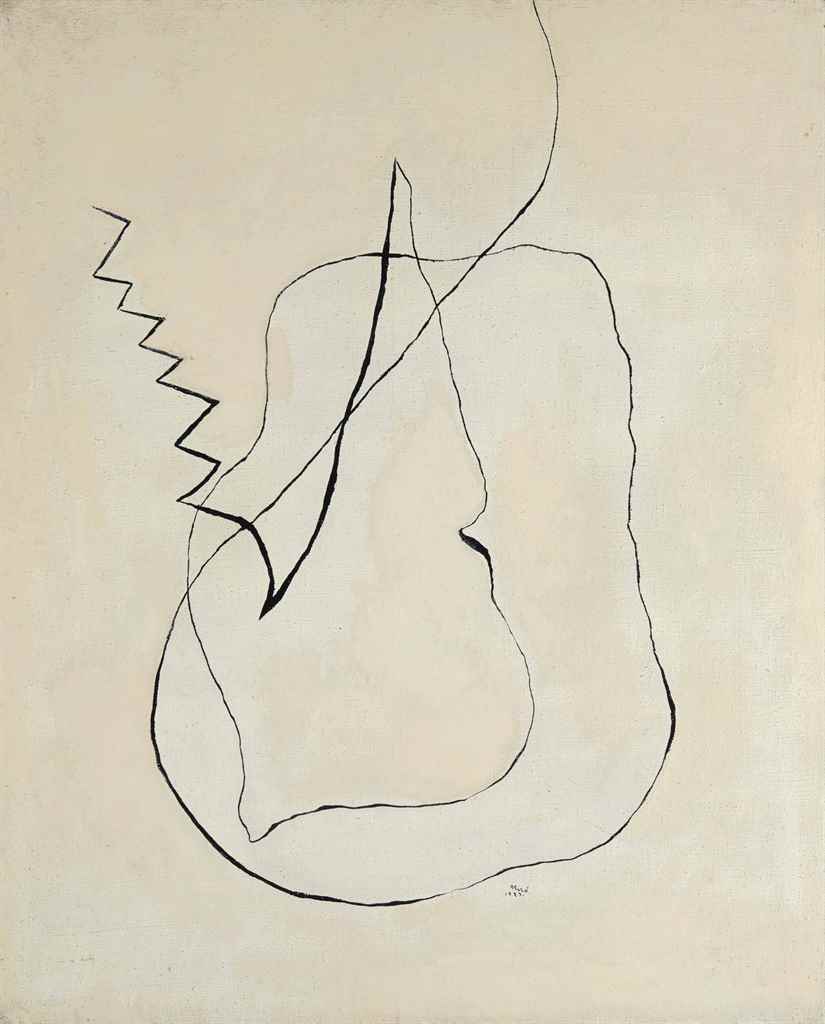
.jpg)
.jpg)
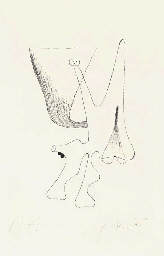

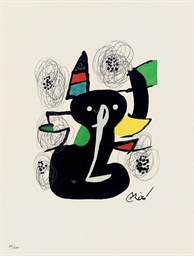
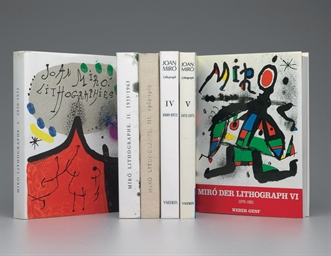
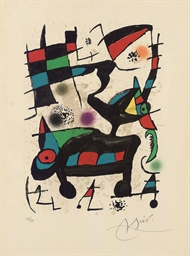
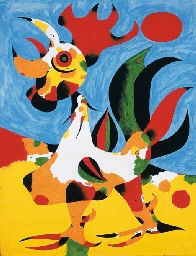
Try LotSearch and its premium features for 7 days - without any costs!
Be notified automatically about new items in upcoming auctions.
Create an alert